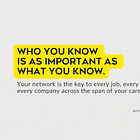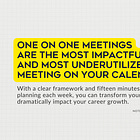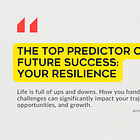On Your First Thirty Days: Expanding Your Network & Executing for Success
Developing relationships and finding quick wins in a new role will establish the foundation for your tenure in a new role
The first thirty days on a new job create the solid foundation for future success. With a focus on learning, relationship-building, and early contributions, you can navigate this period with confidence. Your new role is a chance to advance your career and grow as a professional.
Overview of the First 30 Days
The final two components of your first thirty days in a new role: expanding your network with your new peers & colleagues as well as the final preparation to begin executing in your role.
Step Five: Expanding Your Internal Network
Your first thirty days in a new role will provide the opportunity to meet your peers, colleagues, leaders, and others throughout the organization. Your network will expand organically as you introduce yourself and build relationships across the company.
A vibrant company network opens lines of communication, visibility to initiatives and objectives across the organization, and – perhaps most importantly – makes the work more enjoyable, fulfilling, and purpose-driven.
Need additional insight on how to build your network? Read more:
To build and expand your internal company network:
Identify Key Colleagues
The most important colleagues in your new role are the people you collaborate and interact with on a daily or weekly basis. Building relationships with these colleagues ensures that you have open communication and collaboration, as well as a direct network for additional support. Your key colleagues should include:
Your Manager: Regular one-on-ones with your manager are essential for discussing your progress, expectations, and any challenges you’re facing. These meetings can also be a platform for receiving feedback and guidance on your career development.
Your Teammates: Meet with individual team members to understand their roles and goals, how your work intersects with theirs, and how you can support each other.
Cross-Departmental Colleagues: Consider meeting with colleagues from other departments who you’ll interact with regularly. Understanding their perspectives can provide valuable insights into the broader company operations.
Mentors or Advisors: If you’ve identified a mentor or have been assigned one, regular check-ins will foster this relationship, offering you a channel for gaining industry insights, advice, professional feedback, and development tips.
Meet One-on-One with Your Colleagues
Arrange one-on-one meetings with key stakeholders and team members to understand how you can work together.
Need guidance on how to schedule & manage a 1:1 meeting? Read more:
Meeting with your colleagues is a vital strategy for building strong professional relationships, gaining insights, and enhancing communication with your colleagues, managers, and mentors, especially when you're new to a job. These meetings provide a private space for open dialogue, feedback, and mentorship that can significantly contribute to your personal growth and integration within the company.
Introduce Yourself to Other Departments
Don’t limit your introductions and networking to your immediate team. Understanding how various departments interact with yours can provide valuable context for your role. Learning about different departments within your new company is a strategic approach to broadening your understanding of the organization's operations and culture.
Leveraging the colleagues you’ve met throughout the onboarding process, determine who in your team or company is a knowledgeable resource for various questions outside your team.
Once you’ve identified departments of interest or relevance to your role, consider reaching out to individuals in those departments for informational interviews. These are casual conversations where you can learn about their projects, challenges, and how they contribute to the company’s goals.
To make the most of these meetings, come prepared with specific questions. You might ask about the department’s key functions, current projects, how they measure success, or how your roles might intersect.
Introducing yourself is the first step toward becoming part of the company’s community. By preparing a brief introduction, approaching colleagues with confidence and openness, and engaging actively, you set the stage for positive relationships and a successful integration into your new role.
Remember, the connections you start building from day one can significantly enrich your work experience and support your career development. This network can enhance your ability to contribute effectively, foster cross-departmental collaboration, and potentially open opportunities for career advancement.
Check-In Regularly
While the initial one-on-one meetings help establish relationships and set the tone for your role, ongoing check-ins are crucial for maintaining open lines of communication and fostering long-term professional development.
Check-ins may be dedicated meetings or informal interactions. These touchpoints are invaluable tools for personal and professional development, offering direct lines of communication that can help you thrive in your new role.
Seek Feedback
Seek feedback from your network to adjust and improve your performance – and your professionalism - quickly. Feedback helps you to understand how your work is perceived, identifies areas for improvement, and aligns your performance with the expectations of your role and the company's goals.
Don’t wait for formal review cycles to seek feedback. Requesting feedback early in your tenure and regularly thereafter helps you adjust quickly and make a positive impact in your new role. Plan to ask for feedback after completing significant tasks or projects, or when you’ve been in your role for a set period, such as the thirty day milestone.
Use the feedback to devise specific actions or changes you can make to improve. Consider sharing this plan to show your commitment to using their input constructively.
Step Six: Reflecting & Executing
As you near the end of your first thirty days in a new role, you will establish an ongoing cycle of execution and reflection. The first iteration of this cycle is the reflection of what you’ve learned and observed throughout the onboarding process as well as the initial plan, prioritization, and communication for your first contributions to the team and to the company as a whole.
To complete the first cycle of reflection & execution:
Observe & Reflect on the Bigger Picture
Throughout the onboarding process, spend time actively listening, observing, and reflecting on your knowledge of the team's current challenges, goals, and priorities. These insights will help you identify areas where your contributions can have impact.
Ensure that the work you’re responsible to deliver aligns with both your team's and the organization's broader objectives. This alignment ensures that your efforts contribute positively to the company’s strategy and goals.
Start a Career Journal
Consider keeping a journal to capture your learnings throughout the onboarding process and beyond. This space will help you crystallize your reflections for personal growth, challenges faced, and the progress you’re making in your new role.
Keep a record of your achievements, the skills you’ve developed, and the feedback you’ve received. This documentation can be invaluable during performance reviews and when planning your next career moves.
Regular reflection on your experiences, what you’ve learned, and how you’ve applied your knowledge helps you understand what’s working and what isn’t, allowing you to make informed adjustments to your development plan.
Need a template for your career journal? Use the Notes from the Field Blueprint to establish goals, track progress, and reflect on your journey.
Communicate, Collaborate, Prioritize
Before diving into any project, discuss your ideas for execution with your manager or team to get their input and buy-in. This collaborative approach ensures that your efforts are aligned with team expectations and goals.
Let your manager and team know what you plan to tackle, how you intend to do it, and the expected impact. Keeping others informed not only fosters transparency but also invites support and collaboration.
Work with your manager to understand the priorities of your tasks. Knowing what's urgent and important will help you allocate your time and resources effectively.
When planning your tasks, set realistic deadlines for yourself and communicate these timelines to your team or manager. This helps manage expectations and reduces stress.
Plan for Success
As you begin executing in your role, look for the “quick wins” – the results or outcomes that can be accomplished by the sixty day mark. Quick wins are tasks or projects that can be completed relatively easily and quickly, yet have a noticeable impact on your team or company – and show your initiative and value.
Identifying and achieving quick wins is a strategic way to build momentum, establish credibility, and demonstrate your value early in your role. Here’s how to identify and leverage quick wins in your new job:
Leverage Your Strengths: Look for opportunities where your specific skills and experiences can be applied effectively. Tackling tasks that play to your strengths increases the likelihood of success and allows you to make a strong impression.
Balance Impact with Effort: Evaluate potential quick wins based on the impact they will have versus the effort required. Ideal quick wins are those that are relatively low effort but yield significant benefits or improvements.
Focus on Quality: While quick wins are typically achieved in a short timeframe, it’s important to maintain a high standard of quality in your work. The excellence of your execution will be a testament to your professionalism and attention to detail.
Manage Your Time Effectively: Prioritize your tasks and manage your time efficiently to ensure that your pursuit of quick wins doesn’t detract from other responsibilities or longer-term projects.
Establish Your Routine
Developing and maintaining a routine is an ongoing process that requires commitment and flexibility. By establishing habits early in your new job, you set yourself up for a successful career, characterized by efficient work practices, high-quality outputs, and a satisfying professional life.
Craft your daily routine that balances your productivity, your manager’s expectations, and your personal well-being. A few ideas to get you started:
Start and end your work day at a consistent time
Schedule short breaks in your work day to clear your head or enjoy a meal
Time specific parts of your day and week with consistent, ongoing, or repeated tasks necessary to your work
Engage in uninterrupted focus time to advance or complete complex projects or deliverables
Delineate times for collaboration with your peers and colleagues
Periodically review your productivity habits. What’s working? What isn’t? Being adaptable and willing to adjust your strategies is key to finding what best suits your working style.
Allocate time for learning new skills or tools that can increase your efficiency or quality of work. Staying up-to-date with industry trends and best practices can also contribute to your productivity.
Report Your Results & Outcomes
After completing a project, take the time to evaluate the outcome and the impact of your efforts. Understanding what worked well and what could be improved will guide your approach to future projects.
Share the results of your work with your manager and team. Highlighting the positive outcomes helps build your reputation as a proactive and results-oriented team member; noting the sub-optimal or negative impacts establishes trust, especially when combined with ideas on how to improve outcomes.
Use the momentum generated by your wins to tackle more significant challenges. Building on your early successes can help accelerate your integration into the team and contribute to your long-term success in the role.
Staying open and adaptable in a new job is crucial for navigating the uncertainties and opportunities that come with entering a new work environment. This approach allows you to embrace change, learn from diverse experiences, and grow within your role and the organization.
Adopt the perspective that challenges are opportunities for learning and growth, not obstacles. This mindset encourages you to tackle difficulties with enthusiasm and creativity.
Cultivate an attitude of curiosity about your work, the organization, and the industry. Asking questions not only helps you learn but also demonstrates your engagement and interest in your role.
Dedicate time to expand your knowledge and skills, whether through formal education, workshops, or self-directed learning. Stay updated on industry trends and best practices.
Actively seek and remain open to feedback, even when it's not constructive. Use it as a tool for learning and improvement, rather than viewing it as criticism.
Need some additional guidance to develop your resilience? Read more:
Beyond the First Thirty Days
Transitioning from the initial thirty days to the months ahead, it’s vital to maintain the momentum you’ve built. Continue to nurture the relationships you’ve established, take on new challenges with enthusiasm, and remain committed to your personal and professional development. Finally, establish the milestone objectives to achieve. For example:
60 Day Objective: Demonstrate a quick win (or two) within your team
90 Day Objective: Show initial impact to a specific company objective
6 Month Objective: Report on the outcomes you’ve achieved in your role
1 Year Objective: Commit to a more complex, collaborative project
Good luck in your new role - we’re here at your side throughout this ongoing journey, so subscribe now to ensure you never miss an opportunity for continued development.









